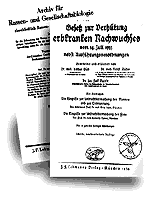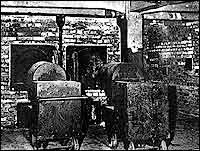
|



know of trials where all participants were agreed that the only insane person was the mad doctor present in the court room as an expert witness.”
– Extract from a speech to the German Parliament by its member Julius Lenzmann, January 16, 1897
Observers at the Nuremberg trials observed that without psychiatry, the Holocaust probably never would have happened.
Why did it happen in Germany?
In the late 19th and early 20th centuries, psychiatrists in Germany developed the hoax of eugenics, which, in turn, led to Hitler’s political ideology that the race must be improved by cleansing it of “inferior stock.” These psychiatrists helped push Hitler into power, clothed Nazi atrocities in pseudo-scientific terms and through their euthanasia program provided “authoritative” justifications for the killings.
The practical and mental imperialism of psychiatry is illustrated by the work of Erwin Stransky, a psychiatrist and racial hygiene advocate. In 1918, he outlined his ideas in the General Magazine for Psychiatry:
“When we, as court experts, are modestly standing in front of the judge, we should always keep in mind that by reason and merit the judge’s chair is actually our rightful place.”
He urged psychiatrists to “restrain and dominate the human mind in the sense of race hygiene and for protection of the society. Then—almost automatically—our profession will get its proper part of this domination....”
Simon Wiesenthal, head of the Jewish Documentation Center in Vienna, wrote in his book The Murderers Amongst Us that even the SS looked up to psychiatrists as the most experienced professional killers—an ideal to follow. That psychiatrists had already murdered Germans considered inferior due to physical defects provided the SS with a rationale for slaughtering Jews, whom they held to have no value at all, especially after the 1935 Nuremberg laws deprived Jews of citizenship. Thus, psychiatric ideology and techniques as used in the euthanasia program formed the basis for the Holocaust.
By 1939 the euthanasia program was already in full operation. In one psychiatric institution, Egelfing-Haar near Munich, 25 children were discovered being starved to death. The director, a Dr. Pfannmuller, proudly explained to a visitor that, “We don’t do it with poison or injection. Our method is far simpler and more natural.” With these words, he picked up a starving and crying child from a bed and held the child up like a dead rabbit. Methodically, he described how food was not fully withdrawn from the children but instead cut down gradually. “This child will live another two or three days,” the psychiatrist commented unemotionally.
Robert E. Abrams, a soldier in World War II who later became a publisher in New York, reported that three months after the end of the war in 1945, he learned from a local medical doctor that in a Bavarian psychiatric hospital, psychiatrists continued their euthanasia program undisturbed. As it turned out, the head of the hospital had been arrested as a Nazi, but the remaining psychiatrists simply carried on. The investigation showed that children were killed until 33 days after the occupation; the last adult had died 12 hours before the military investigators’ arrival.
The American Frederick Wertham, editor of respected studies about the cruelties of National Socialism psychiatry, wrote in his book, A Sign for Cain, that the number of patients in psychiatric hospitals was 300,000 to 320,000 in 1939—but only 40,000 in 1946. The rest had been murdered at the hands of psychiatric science.
Many of the psychiatrists who had condemned these patients to their deaths simply went on practicing their trade in Germany after the war was over. Werner Heyde, with four others, had been the first psychiatrist to enter Dachau to organize the selection of patients for elimination and became chief organizer and “medical director” of the Nazi extermination program. After hostilities were over, he practiced psychiatry in Germany for many years under an alias, even becoming an expert witness in court. Colleagues who knew his real identity kept silent.
Hans Heinze, director of the Heilanstalt Brandenburg-Goerden—a mental institution turned killing center—supervised the murder by injection, starvation and poisoning of thousands of children whose brains Heinze then supplied to Nazi “researchers.” Other euthanasia camps sent their Nazi “physicians” to Heinze for training in the most efficient methods of killing.
After the war Heinze received only a token sentence of seven years, a mere slap on the wrist relative to the gravity of his crimes. Upon release, he was welcomed back into psychiatric ranks and became the chief physician for adolescent psychiatry at Wunstdorf state hospital. Children were once again his patients.
The roster of presidents of the German Association of Psychiatry from the end of the war onward shows how psychiatrists who were either directly involved in the killings, or had been students of other psychiatrists who were involved, continued to dominate psychiatry:
1948-1951: Ernst Kretschmer, a Nazi psychiatrist who had been directly involved in the euthanasia program.
1952-1954: Werner Villinger. Villinger ordered thousands to their deaths in the gas chambers. After the war, he helped to found the Federal Ministry of Family, Youth and Health, where he installed one of his students, Dr. Manger-Koenig. Villinger was honored by the German government.
1957-1958: Friedrich Mauz. Mauz was a Nazi psychiatrist who had been active in the euthanasia program.
1965-1968: Friedrich Panse. A Nazi psychiatrist who had been an “expert” during the extermination program. The experts decided who went to the gas chambers.
1969-1971: Helmuth Ehrhardt, a student of and author of a laudatory biography of Werner Villinger. In the book, Ehrhardt praised both Villinger and Max De Crinis, another psychiatrist heavily involved in the killing program. Ehrhardt belittled the severity of the crimes these men had committed and cited the “comparatively few mental patients” killed.
1973-1974: Hans Hippius, a student of Villinger.
1979-1980: Hanfried Helmchen, an advocate of Nazi psychiatrists and their ideology.
In fact, between 1948 and 1980, only three presidents were either anti-Nazi or had no apparent connection with the psychiatrists who had conducted the euthanasia program. Their cumulative period of presidency was no more than five years out of a total of 32.
In 1961, Austrian psychiatrist Hans Hoff—like Ehrhardt, an admirer of Villinger—published a book entitled Contemporary European Psychiatry. In it, he justified sterilization of the mentally ill by claiming that so long as it was recommended by psychiatric advisers to the German Eugenic Courts, it was scientific.
Both Hoff and Ehrhardt rose to high levels in their industry. In 1959, Hoff was appointed president of the World Federation of Mental Health (WFMH). Nine years later, Ehrhardt was elected to the WFMH’s executive board.
These are but a few examples illustrating that theories provided the Nazis with their pseudo-intellectual ideology have continued long after the Nazi regime itself perished from the world.
|

|








